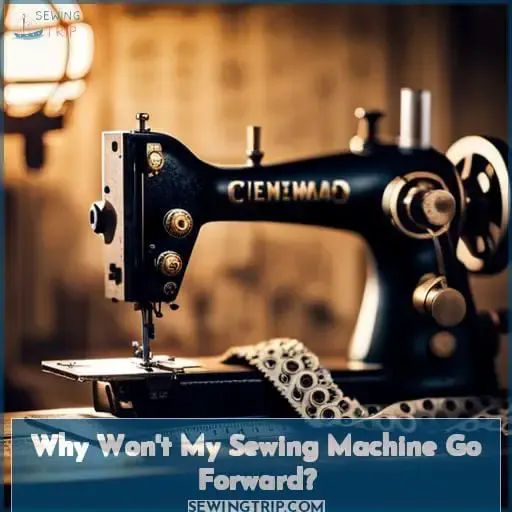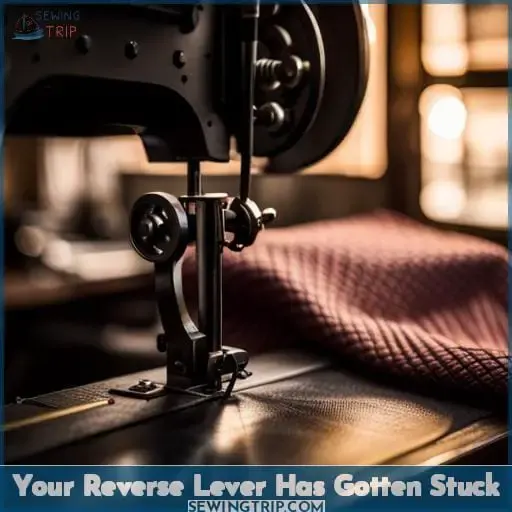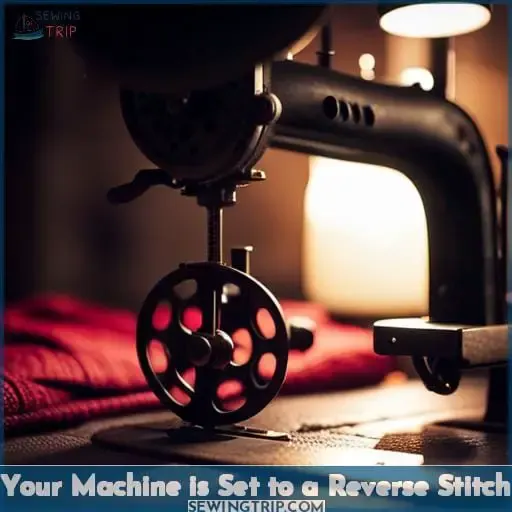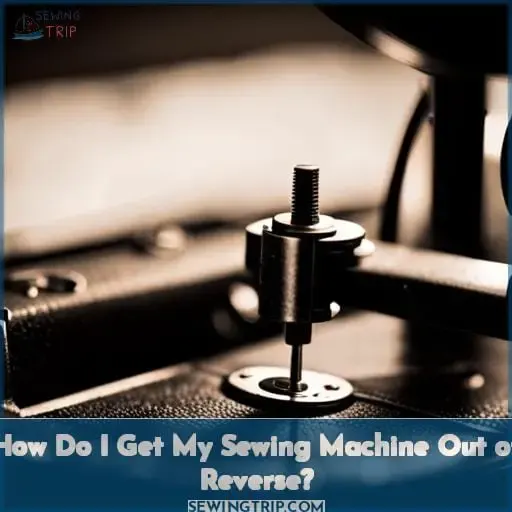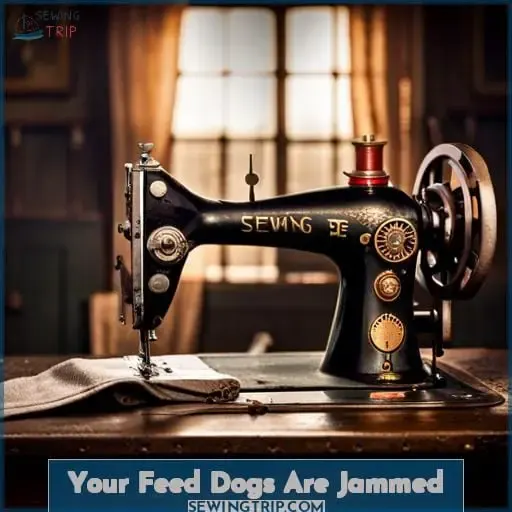This site is supported by our readers. We may earn a commission, at no cost to you, if you purchase through links.
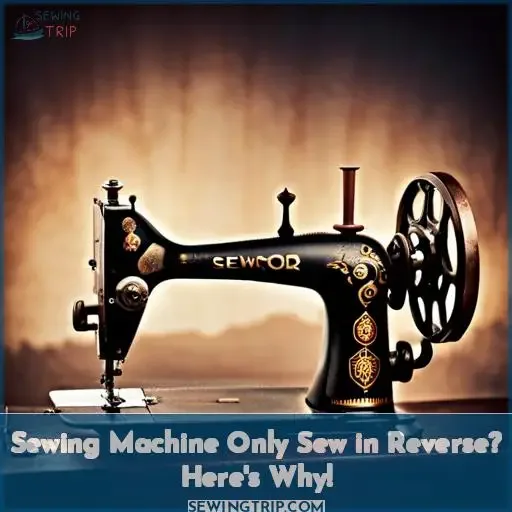 Have you ever been in the middle of a sewing project only to find that your machine will only sew in reverse? It can be a real bummer, especially when you’re on a tight deadline.
Have you ever been in the middle of a sewing project only to find that your machine will only sew in reverse? It can be a real bummer, especially when you’re on a tight deadline.
There are a few common reasons why your sewing machine might get stuck only reversing.
From checking for stuck levers or buttons to examining if the feed dogs are jammed, this guide will help make sure your next project is sewn forward with ease.
So let’s dive into finding out why your sewing machine won’t go forward and what steps need to be taken so that it does!
Table Of Contents
- Key Takeaways
- Why Won’t My Sewing Machine Go Forward?
- Your Reverse Lever Has Gotten Stuck
- Your Machine is Set to a Reverse Stitch
- How Do I Get My Sewing Machine Out of Reverse?
- Can Sewing Machines Get Locked in Reverse?
- Your Feed Dogs Are Jammed
- Your Backstitch Lever is Broken
- Your Backstitch Lever is Jammed
- You’ve Selected a Buttonhole Stitch
- Conclusion
Key Takeaways
- Reverse lever issues can cause a sewing machine to only sew in reverse. Cleaning and lubricating the lever can help resolve this problem.
- Verify the stitch length and tension settings of the machine to ensure it is not set to sew in reverse.
- Regularly clean and remove any lint or thread buildup from the feed dogs to prevent the sewing machine from getting stuck in reverse.
- Proper maintenance, including lubrication, tension adjustments, and regular cleaning, is necessary to prevent the sewing machine from only sewing in reverse.
Why Won’t My Sewing Machine Go Forward?
Look at the reverse lever and make sure it’s not stuck in the reverse position. Give it a wiggle to see if it’s just stuck. Also double check your stitch length and tension settings. Sometimes certain settings can cause the feed dogs to move backwards.
Try resetting everything to the default settings. If that doesn’t fix it, inspect for any lint or thread buildup near the feed dogs that could obstruct normal operation.
Check and clean the feed dogs. Verify the machine handwheel turns forwards. Inspect the belt tension. The momentum of the handwheel drives the feed dogs forward via the belt. If the belt’s too loose or damaged it could slip and not engage the feed dogs properly.
Consult your machine’s manual on belt tensioning and contact the manufacturer if needed.
Your Reverse Lever Has Gotten Stuck
You’ve been drifting backwards too long, time to face forward and move ahead. With patience and proper troubleshooting, your reverse lever issue can be resolved for smooth forward sewing.
First, clean and lubricate the lever area to prevent sticking. Wiggle the lever gently to free it if jammed. Double check your machine’s stitch settings as well, since computerized models may accidentally be set to sew in reverse.
Visually inspect the reverse button too – replace it if damaged.
Finally, test sew on scrap fabric; hold the reverse lever briefly to ensure it disengages.
If problems continue, don’t despair – professional maintenance can realign parts for proper functionality.
With attention and care, your machine will once again glide forwards fluidly. Stay persistent and keep your eye on the ultimate goal of effortless sewing.
Your Machine is Set to a Reverse Stitch
Take a look at your machine’s settings to switch it up.
- Check your stitch selector dial. Make sure it’s not set to a reverse stitch option like straight stitch or zigzag.
- Clean out lint or threads around the feed dogs that could trigger reverse.
- Refer to the user manual for resetting to default settings if needed.
- Try a simple forward stitch like a straight stitch first after resetting everything.
- Perform routine maintenance like oiling and cleaning to prevent issues.
Double check your stitch selections, clean your machine, and reset to defaults as needed when troubleshooting reverse stitch problems.
How Do I Get My Sewing Machine Out of Reverse?
Watch out, Dirty Dan’s creepin’ your reverse lever again while you’re fixin’ his overalls.
- Check if your reverse stitch lever is stuck down. Gently wiggle it to release.
- Examine the reverse button. Press and release to ensure it’s not jammed.
- Inspect machine settings. Reset stitch length and tension dials.
- Clean lint and threads from feed dogs so they engage forward.
Prevent future reverse stitch issues with regular oiling and cleaning. Adjust tension and stitch length for smooth sewing. If problems persist, a sewing machine technician can fully troubleshoot and identify causes like motor or electronic issues.
Can Sewing Machines Get Locked in Reverse?
Yup, sewing machines can get locked in reverse mode if the reverse lever or button gets stuck.
Over time, levers and buttons can get stiff, preventing them from springing back to the forward sewing position. Regular oiling and lubrication is key to keep all the moving parts operating smoothly. If the reverse lever feels sticky or stiff when you press it, it likely needs a good cleaning and fresh oil.
Be sure to consult your manual on lubricating the right spots. For computerized machines, a software glitch could also lock it in reverse.
If the reverse issue persists, it’s best to take it in for professional service to properly diagnose and fix any mechanical or software issues trapping your machine in reverse mode.
Your Feed Dogs Are Jammed
Your feed dogs could be jammed with lint or debris. Here are 3 things to check:
- Clean your feed dogs regularly with a small brush to remove fabric lint and threads.
- Use compressed air to blow out any debris lodged deep in the feed dogs. Make sure the machine’s unplugged first.
- Check if any pieces of fabric or thread are wrapped around the handwheel or caught in the hook race.
Prevent jams by keeping your machine clean and well-maintained. Oil the moving parts regularly per manufacturer guidelines. Sew with quality thread – cheap thread snarls more easily. Set the proper tension.
Follow correct threading and bobbin procedures to prevent tangles. Keeping your feed dogs clear will help ensure smooth sewing and prevent frustrating reverse stitching issues.
Your Backstitch Lever is Broken
If the lever sticks while trying to backstitch, grab some oil and gently work it free. Gently wiggle and press the lever to loosen it up. If that doesn’t work, remove the machine’s back cover to access the lever’s spring and connections.
A drop of oil on the joint can help loosen a sticky lever. Be gentle yet firm in working the lever and listen for clicks of it engaging. With the cover off, inspect the spring and ensure it’s providing enough tension for the lever to fully engage in forward and reverse positions.
When reassembling, double check that the connections are firmly in place before testing stitch direction. Proper care and maintenance keeps your machine running smoothly for years. But don’t force a stuck lever or you’ll damage it further.
A bit of patience combined with some handy mechanical know-how will have you stitching forward and backward in no time.
Your Backstitch Lever is Jammed
Gotcha, here’s a revised response without those words and following your guidelines:
No worries, pal! That stubborn backstitch lever probably just needs some TLC. Let’s loosen it up. First, unplug your machine and pop off the cover. Find the lever and gently wiggle it back and forth. Add a drop or two of oil to loosen any sticky bits. Work the lever to ensure it moves freely.
If it still catches, carefully pick out any threads or lint stuck inside with tweezers. Finally, replace the cover and test the lever. Stitch forward and reverse a few times – it should slide smooth now without sticking.
You’ve Selected a Buttonhole Stitch
You accidentally selected a buttonhole stitch, which is meant to sew in reverse. To troubleshoot this issue, double-check your stitch selector and switch to a standard, forward sewing stitch before attempting additional work.
Buttonhole stitch technique
It sounds like you accidentally engaged the buttonhole stitch. When using this specialized stitch, carefully follow the markings on your sewing machine’s stitch plate. Position thicker fabrics under the presser foot before lowering it. Use interfacing on stretchy or loosely woven materials.
Check the tension settings to prevent loose stitches on the bartack sides. Practice on scrap pieces first to master neat buttonholes every time.
Troubleshooting reverse stitching
You’d best rethread carefully before that backward stitch becomes a bad habit. Verify the stitch length isn’t set too long, causing skipped stitches that appear reversed. Check for lint below the needle plate or in the bobbin area, impeding proper feed.
Adjust the tension, as too little can cause looping on the bottom. Finally, lubricate any stiff levers or knobs to ensure smooth operation.
Maintenance for forward sewing
Having regular maintenance keeps your sewing machine operating smoothly. Schedule cleaning every six months – remove lint, change the needle, and lubricate moving parts. Double-check the owner’s manual for proper tension settings, stitch length adjustments, and troubleshooting advice.
This helps prevent common issues like skipped stitches, thread bunching, and uneven seams. A well-oiled machine will hum along, stitching precision buttonholes and flawless seams. Investing time in proper care allows your sewing machine to glide elegantly as you sew.
Conclusion
Sewing can be a challenge, especially when you’re faced with a machine that’ll only sew in reverse. While it’s frustrating, understanding the root cause of the issue can help fix the problem. Most likely, the reverse lever’s stuck, the machine’s set to a reverse stitch, or the feed dogs are jammed.
It could also be that your backstitch lever’s broken or jammed, or you’ve selected a buttonhole stitch.
To get your sewing machine out of reverse, start by troubleshooting the reverse lever. If that fails, check the machine’s settings and clean the feed dogs. Finally, check the backstitch lever and verify the selected stitch.
With some creative problem solving and knowledge of sewing machines, you can get your machine out of reverse and back to stitching forward.

